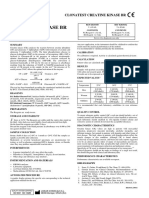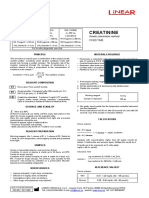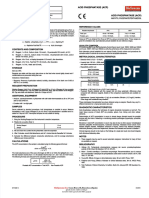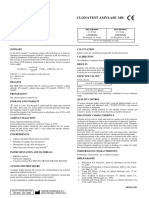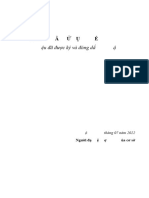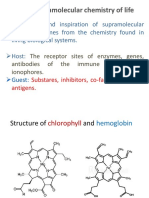Creatine Kinase (CK)
Creatine Kinase (CK)
Uploaded by
Mira SafwatCopyright:
Available Formats
Creatine Kinase (CK)
Creatine Kinase (CK)
Uploaded by
Mira SafwatCopyright
Available Formats
Share this document
Did you find this document useful?
Is this content inappropriate?
Copyright:
Available Formats
Creatine Kinase (CK)
Creatine Kinase (CK)
Uploaded by
Mira SafwatCopyright:
Available Formats
T h e C r e a t i v e A p p r o a c h t o B i o s c i e n c e
Creatine Kinase (CK)
REF: 238 001 ( 6 x 5 ml ) 60 Test
REF: 238 002, ( 6 x 20 ml ) 240 Test
REF: 238 004 ( 6 x 10 ml ) 120 Test
Intended Use Reagent preparation, Storage, and Stability
Spectrum Diagnostics Creatine Kinase (CK) reagent is intended for
REF: 238 001 add 1 ml from R2 to one bottle of R1; mix gently
the in-vitro quantitative, diagnostic determination of Creatine kinase
REF: 238 002 add 4 ml from R2 to one bottle of R1; mix gently
in human serum on both automated and manual systems. REF: 238 004 add 2 ml from R2 to one bottle of R1; mix gently
Or prepare the working solution according to the number of test
Background required by mixing 4 volumes of R1 with 1 volume of R2. Stability:
4 weeks at 2-8oC away from light sources.
Creatine kinase (CK) is an enzyme which is found in heart, brain
and skeletal muscles. Thus, an increase of circulating level of CK
may be associated to myocardial infarction, acute cerebrovascular
Specimen Collection and Preservation
disease, trauma or diseases of skeletal muscles. After a myocardial Serum free of haemolysis or heparin plasma. Stability 2 days at
infarction, CK level begins rising between 4th and 6th hour after first 20-25 oC, 7 days at 2-8oC, 4 weeks at -20oC protected from light.
acute symptoms, reaching the peak between 18th and 30th hour
and coming back to normal values during the 3rd day. CK is present
in three different isoenzymatic forms, which could be separated by System Parameters
electrophoresis or column chromatography; each form is originated
in different body tissues, paying off their diagnostic determinations. Wavelength 340 nm (334-365 nm)
The formula of present reagent is based on DGKC and IFCC Optical path 1 cm
recommendations. Assay type Kinetic
Direction Increase
Sample: Reagent Ratio 1:25
Method e.g.: Reagent volume 1 ml
Sample volume 40 l
According to the recommendations of the International Federation Temperature 37 oC
of Clinical Chemistry (IFCC).
Equilibration Time 60 seconds
Read time 1 to 3 minutes
Assay Principle Zero adjustment against air
Reagent blank limits
Creatine kinase (CK) catalyzes the phosphorylation of ADP, in the Sensitivity 1 U/L
presence of creatine phosphate, to form ATP and creatine. The Linearity 2000 U/L
catalytic concentration is determined from the rate of NADPH
formation, measured at 340 nm, by means of the hexokinase (HK) Procedure
and glucose-6-phosphate dehydrogenase (G6PDH) coupled
Reactions1,2. 1. Pipette into a thermostatized cuvette:
Creatine phosphate + ADP CK Creatine + ATP
ATP + Glucose HK ADP + Glucose-6-phosphate Working solution 0.5 ml
Glucose-6-phosphate+NADP+ G6PDH 6-Phosphogluconate+NADPH+ H+ Serum 20 L
Reagents
Reagent 1 (pH 6.7) (Buffer / Coenzyme) 2. Mix and incubate 60 seconds.
Imidazol 125 mmol/L 3. Read initial absorbance (A) of the sample, start the stopwatch
D-Glucose 25 mmol/L and read absorbance at 1 minute intervals thereafter for 3 minutes.
N-Acetyl-L-Cysteine 25 mmol/L 4. Calculate the difference between absorbances and the average
Magnesium acetate 12.5 mmol/L absorbance differences per minute (A/min).
NADP 2.5 mmol/L
EDTA 2 mmol/L Calculation
Reagent 2 (Enzymes) A/min x 4127 = U/L CK
ADP 15.2 mmol/L
AMP 25 mmol/L Units: One international unit (IU) is the amount of enzyme that
P1,P5-di (adenosine-5'-) penta-phosphate 103 mmol/L transforms 1 mol of substrate per minute, in standard conditions.
Glucose-6-phosphate Dehydrogenase (G6PDH) 9 KU/L The concentration is expressed in units per liter of sample (U/L).
Creatine phosphate 250 mmol/L
Hexokinase (HK) 3 KU/L Expected values
Precautions and Warnings
Men 24 - 204 U/L
Do not ingest or inhalate. In case of contact with eyes or skin; rinse
immediately with plenty of soap and water. In case of severe injuries; Women 24 - 173 U/L
seek medical advice immediately.
Storage and Stability Quality Control
The reagents are stable up to the expiration date specified when Normal & abnormal commercial control serum of known concentrations
stored at 2 – 8 oC.Once opened, the reagent is stable for 2 months should be analyzed with each run.
at the specified temperature.
Performance Characterstics
Precision
Within run (Repeatability)
Level 1 Level 2
n 20 20
Mean (U/L) 86 616
CV% 2.8 1.0
Run to run (Reproducibility)
Level 1 Level 2
n 20 20
Mean (U/L) 77 624
CV% 2.5 0.8
Methods Comparison
A comparison between Spectrum Diagnostics CK reagent and a
commercial reagent of the same methodology was performed on 20
human sera. A correlation of 0.983 was obtained.
Sensitivity
When run as recommended, the minimum detection limit of the
assay is 1 U/L.
Linearity
The reaction is linear up to CK concentration of 2000 U/l; specimens
showing higher concentration should be diluted 1+2 using physiological
saline and repeat the assay (result×3).
Interferences:
No interferences were observed with haemoglobin until 5 g/L, bilirubin
20 mg/dL and triglycerides 7 mmol/L. Other drugs and substances
may interfere3,4.
References
1. IFCC methods for the measurement of catalytic concentration of
enzymes. Part 7: IFCC method for creatine kinase. JIFCC 1989;
1: 130-139.
2. Tietz Textbook of Clinical Chemistry, 3rd edition. Burtis CA,
Ashwood ER. WB Saunders Co., 1999.
3. Young DS. Effects of drugs on Clinical Lab. Tests, 4th ed AACC
Press, 1995.
4. Young DS. Effects of disease on Clinical Lab. Tests, 4th ed AACC
2001.
ORDERING INFORMATION
CATALOG NO. QUANTITY
238 001 6 x 5 ml
238 002, 6 x 20 ml
238 004 6 x 10 ml
Egyptian Company for Biotechnology (S.A.E)
Obour city industrial area. block 20008 piece 19 A. Cairo. Egypt.
Tel: +202 4489 2248 - Fax: +202 4489 2247
www.spectrum-diagnostics.com
E-mail:info@spectrum-diagnostics.com
MDSS GmbH
EC REP Schiffgraben 41
30175 Hannover, Germany
IFUFCC11 Rev.(12), 6/6/2021
You might also like
- Teco Diagnostics: Alt (SGPT) Liquid Reagent (Kinetic Method)No ratings yetTeco Diagnostics: Alt (SGPT) Liquid Reagent (Kinetic Method)2 pages
- Quantitative Determination of Alkaline Phosphatase (ALP)No ratings yetQuantitative Determination of Alkaline Phosphatase (ALP)2 pages
- BSIS77 CREATININA Enzimatica 1001115-17 2011No ratings yetBSIS77 CREATININA Enzimatica 1001115-17 20112 pages
- Potassium-Single-Reagent Leaflet SpectrumNo ratings yetPotassium-Single-Reagent Leaflet Spectrum2 pages
- Cholinesterase Bi: Quantitative Determination of Cholinesterase (CHE)No ratings yetCholinesterase Bi: Quantitative Determination of Cholinesterase (CHE)4 pages
- Lyphase 11760I-Reagent A 510 Reagent B 300 Sample 9 Standard 113No ratings yetLyphase 11760I-Reagent A 510 Reagent B 300 Sample 9 Standard 1131 page
- Creatinine: Prepare The Required Quantity of Working Reagent For The Analytical SessionNo ratings yetCreatinine: Prepare The Required Quantity of Working Reagent For The Analytical Session2 pages
- Considerations For Operating Pressure Vessels Below - 20°F PDFNo ratings yetConsiderations For Operating Pressure Vessels Below - 20°F PDF14 pages
- HR Policies and Its Implementation at Deepak NitriteNo ratings yetHR Policies and Its Implementation at Deepak Nitrite86 pages
- Commonly Occuring Anti-Nutrients & Toxicants in Feed IngredientsNo ratings yetCommonly Occuring Anti-Nutrients & Toxicants in Feed Ingredients30 pages
- PHY13 Lesson 4 Diffraction and InterferenceNo ratings yetPHY13 Lesson 4 Diffraction and Interference44 pages
- Comprehensive Step by Step Calculations For Retaining Wall Analysis Are Provided BelowNo ratings yetComprehensive Step by Step Calculations For Retaining Wall Analysis Are Provided Below15 pages
- Sterile Micro-Filtration For BioreactorsNo ratings yetSterile Micro-Filtration For Bioreactors4 pages
- Biomaterials in Orthodontics / Orthodontic Courses by Indian Dental Academy100% (2)Biomaterials in Orthodontics / Orthodontic Courses by Indian Dental Academy150 pages
- Transcutol Aplicaciones Industria Del Cuidado Personal100% (1)Transcutol Aplicaciones Industria Del Cuidado Personal24 pages








